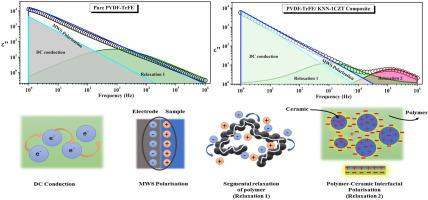Polymer ( IF 4.6 ) Pub Date : 2021-09-06 , DOI: 10.1016/j.polymer.2021.124164 Sushmita Dwivedi 1 , Manish Badole 1 , Kaushal Gangwar 1 , Sunil Kumar 1

|
Polymer-ceramic composites have gained considerable attention in flexible electronic devices due to their uncommon features such as high dielectric constant, low conductivity, and good mechanical flexibility. The electrical and mechanical responses of various components (ceramic grain & grain boundary, polymer chains, and interface) need to be elucidated to rationally design high-performance polymer-ceramic composites. This paper provides a detailed analysis of dynamic mechanical and frequency-dependent dielectric behaviour with temperature to discern the various mechanisms responsible for the relaxations in the polyvinylidene fluoride-trifluoro ethylene/K0·5Na0·5NbO3–CaZn1/3Ta2/3O3 (PVDF-TrFE/KNN-1CZT) composite fabricated using solution casting technique. The FTIR spectra and x-ray diffraction patterns indicate the existence of the polar β-phase, confirming the ferroelectric nature of polymer films. The ferroelectric-paraelectric phase transition (TC ∼ 130 °C) of polymer film obtained from the DSC & DMA data was corroborated by the dielectric study. The introduction of ceramic fillers in polymer induces an additional relaxation in the 10 kHz to 1 MHz frequency range, owing to the ceramic-polymer interface formation, which is responsible for increment in the dielectric constant and storage capacity of the composites. The effective dielectric constant of the composite was modelled using the Maxwell-Garnet and Yamada models. The enhanced dielectric constant of composite films (εr ∼ 28) with the addition of dielectric filler qualifies these materials for flexible high-performance capacitive devices. Further, this study enables a better understanding of the various relaxation processes in the composite with dielectric fillers.
中文翻译:

PVDF-TrFE 和 KNN 基复合材料中的弛豫过程和传导行为
聚合物陶瓷复合材料由于具有高介电常数、低电导率和良好的机械柔韧性等不常见的特性,在柔性电子设备中得到了广泛的关注。需要阐明各种组件(陶瓷晶粒和晶界、聚合物链和界面)的电气和机械响应,以合理设计高性能聚合物-陶瓷复合材料。本文详细分析了随温度变化的动态机械和频率相关介电行为,以了解导致聚偏二氟乙烯-三氟乙烯/K 0·5 Na 0·5 NbO 3 –CaZn 1/3 Ta弛豫的各种机制2/3 O 3(PVDF-TrFE/KNN-1CZT) 复合材料使用溶液浇铸技术制造。FTIR 光谱和 X 射线衍射图表明存在极性 β 相,证实了聚合物薄膜的铁电性质。 介电研究证实了从 DSC 和 DMA 数据获得的聚合物膜的铁电-顺电相变(T C ∼ 130 °C)。由于陶瓷-聚合物界面的形成,在聚合物中引入陶瓷填料会引起 10 kHz 至 1 MHz 频率范围内的额外弛豫,这是导致复合材料介电常数和存储容量增加的原因。复合材料的有效介电常数使用Maxwell-Garnet和Yamada建模楷模。 添加介电填料的复合薄膜的介电常数 ( ε r ∼ 28) 提高,使这些材料有资格用于柔性高性能电容设备。此外,这项研究可以更好地了解具有介电填料的复合材料中的各种弛豫过程。


























 京公网安备 11010802027423号
京公网安备 11010802027423号